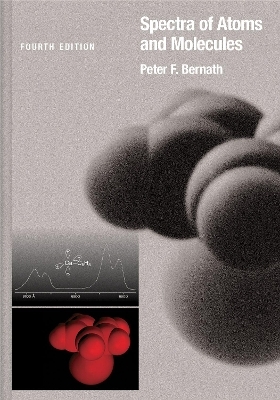
Spectra of Atoms and Molecules
Oxford University Press Inc (Verlag)
978-0-19-009540-6 (ISBN)
This fourth edition of Peter Bernath's successful Spectra of Atoms and Molecules is designed to provide advanced undergraduate and graduate students a working knowledge of the vast field of spectroscopy. Also of interest to chemists, physicists, astronomers, atmospheric scientists, and engineers, this volume emphasizes the fundamental principles of spectroscopy with the primary goal of teaching the interpretation of spectra. Features include a presentation of group theory as needed to understand spectroscopy, detailed worked examples and a large number of excellent problems at the end of each chapter.
Bernath provides a large number of diagrams and spectra which have been specifically recorded for this book. Molecular symmetry, matrix representation of groups, quantum mechanics, and group theory are among the topics covered; atomic, rotational, vibrational, electronic and Raman spectra are analyzed as well. Bernath's treatment clears the confusing topic of line strengths as needed for quantitative applications. Responding to student requests, the fourth addition features detailed and worked examples in each chapter. This book has also been updated to include the 2018 CODATA revision of physical constants and a large number of corrections and clarifications. New chapters on atmospheric and astronomical spectroscopy have been added. Spectra of Atoms and Molecules demystifies spectroscopy by showing readers the intermediate steps in a derivation, as well as the final result.
Peter F. Bernath is Professor of Chemistry and Biochemistry at Old Dominion University in Norfolk, Virginia.
Introduction
1.1 Waves, Particles, and Units
1.2 The Electromagnetic Spectrum
1.3 Interaction of Radiation with Matter
Molecular Symmetry
2.1 Symmetry Operations
2.2 Groups
2.3 Notation for Point Groups
Matrix Representation of Groups
3.1 Vectors and Matrices
3.2 Symmetry Operations and Position Vector Basis
3.3 Symmetry Operators and Atomic Basis Vectors
3.4 Symmetry Operators and Basis Functions
3.5 Equivalent, Reducible, and Irreducible Representations
3.6 Great Orthogonality Theorem
3.7 Character Tables
Quantum Mechanics and Group Theory
4.1 Matrix Representation of the Schrodinger Equation
4.2 Born-Oppenheimer Approximation
4.3 Symmetry of the Hamiltonian Operator
4.4 Projection Operators
4.5 Direct Product Representations
4.6 Integrals and Selection Rules
Atomic Spectroscopy
5.1 Background
5.2 Angular Momentum
5.3 The Hydrogen Atom and One-Electron Spectra
5.4 Many-Electron Atoms
5.5 Selection Rules
5.6 Atomic Spectra
5.7 Intensity of Atomic Lines
5.8 Zeeman Effect
5.9 Stark Effect
Rotational Spectroscopy
6.1 Rotation of Rigid Bodies
6.2 Diatomic and Linear Molecules
6.3 Rotational Line Intensities for Diatomic and Linear Molecules
6.4 Symmetric Tops
6.5 Asymmetric Tops
6.6 Structure Determination
Vibrational Spectroscopy
7.1 Diatomic Molecules
7.2 Vibrational Motion of Polyatomic Molecules
7.3 Selection Rules for Vibrational Transitions
7.4 Vibrational Spectra of Polyatomic Linear Molecules
7.5 Vibrational Spectra of Symmetric Tops
7.6 Vibrational Spectra of Spherical Tops
7.7 Vibrational Spectra of Asymmetric Tops
7.8 Vibration-Rotation Line Intensities
7.9 Fermi and Coriolis Perturbations
7.10 Inversion Doubling and Fluxional Behavior
Light Scattering and the Raman Effect
8.1 Background
8.2 Rotational Raman Effect
8.3 Vibration-Rotation Raman Spectroscopy
8.4 Rayleigh and Raman Intensities
Electronic Spectroscopy of Diatomics
9.1 Orbitals and States
9.2 Vibrational Structure
9.3 Rotational Structure of Diatomic Molecules
9.4 The Symmetry of Diatomic Energy Levels: Parity
9.5 Rotational Line Intensities
9.6 Dissociation, Photodissociation, and Predissociation
Electronic Spectroscopy of Polyatomics
10.1 Orbitals and States
10.2 Vibrational Structure of Electronic Transitions
10.3 Vibronic Coupling: The Herzberg-Teller Effect
10.4 Jahn-Teller Effect and Conical Intersections
10.5 Renner-Teller Effect
10.6 Nonradiative Transitions: Jablonski Diagram
10.7 Photoelectron Spectroscopy
10.8 Rotational Structure: H2CO and HCN
10.9 Intensity of Transitions
Atmospheric Spectroscopy
11.1 Introduction
11.2 Atmospheric Spectra
11.3 Radiative Transfer
11.4 Forward and Inverse Models
Astronomical Spectroscopy
12.1 Introduction
12.2 Interstellar Clouds
12.3 Stars and Brown Dwarfs
12.4 Planets, Exoplanets, and Moons
Appendices:
A. Units, Conversion, and Physical Constants
B. Character Tables
C. Direct Product Tables
D. Itnroductory Textbooks
Figure Acknowledgments
Index
| Erscheinungsdatum | 27.05.2020 |
|---|---|
| Verlagsort | New York |
| Sprache | englisch |
| Maße | 183 x 257 mm |
| Gewicht | 1089 g |
| Themenwelt | Naturwissenschaften ► Chemie ► Physikalische Chemie |
| Naturwissenschaften ► Physik / Astronomie ► Atom- / Kern- / Molekularphysik | |
| ISBN-10 | 0-19-009540-7 / 0190095407 |
| ISBN-13 | 978-0-19-009540-6 / 9780190095406 |
| Zustand | Neuware |
| Informationen gemäß Produktsicherheitsverordnung (GPSR) | |
| Haben Sie eine Frage zum Produkt? |
aus dem Bereich


